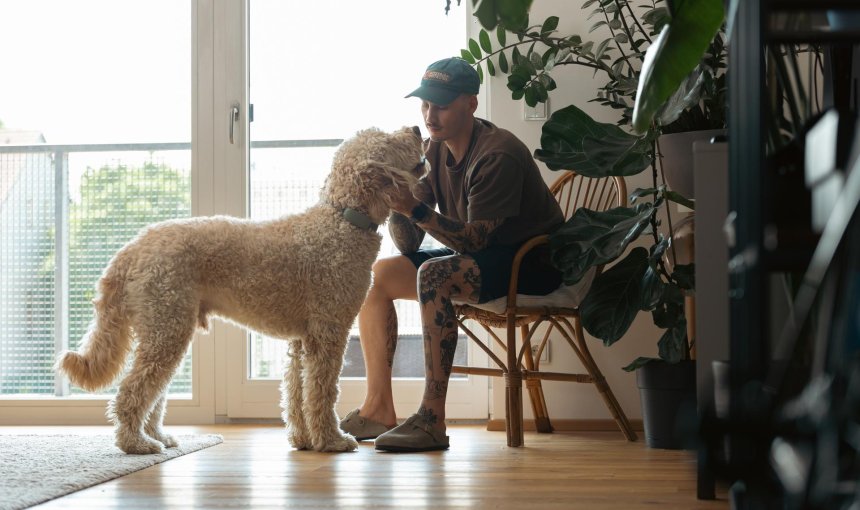 Approved by Dr. Dwight Alleyne, DVM
Approved by Dr. Dwight Alleyne, DVM Signs of Stress in Dogs: What to Watch For (and How to Help)
Is your dog panting more than usual, pacing, or acting out of character? These might be signs of stress or anxiety. Here’s how to recognize them & what steps you can take.

If your dog could talk, they’d probably tell you when something’s up. But since we can’t count on a barked-out monologue, it’s up to us to spot the signs of stress in dogs – and take steps to help them feel safe, calm, and happy. Let’s break down the key signs to watch for, how you can help your pup feel more like themselves again, and where a smart dog tracker like Tractive can help.
Key Takeaways
😟 Stress in dogs can show up as panting, pacing, trembling, or changes in sleep and appetite.
☀️ Heat stress is dangerous and requires immediate action – watch out for signs like excessive panting, red gums, or collapse.
🐶 You can help by creating a calm environment, sticking to a routine, offering mental and physical stimulation, playing calming sounds, and seeking professional help if needed.
🐾 A smart dog tracker like Tractive can alert you to the signs of stress in dogs – like an increase in their breathing or heart rate – giving you insights before problems escalate.

Always know your buddy is healthy & safe
Read moreWhat are the signs of stress in dogs?
Stress, anxiety, and even heat-related issues can all affect your dog’s well-being. Dogs show stress in a bunch of different ways – and sometimes it’s subtle. These are some of the most common signs to keep an eye on:
- Panting (even when it’s not hot)
Is panting a sign of stress in dogs? It definitely could be. If your dog’s panting heavily indoors or during downtime, it could be their way of releasing nervous energy. - Pacing or restlessness
Constant pacing or circling is often a red flag that something’s bothering your pup. - Yawning, lip licking, and drooling
These behaviors aren’t always about being sleepy or hungry – they could be subtle signs your dog is trying to self-soothe. Watch out: excessive drooling in dogs could be a sign of underlying health issues. - Shaking or trembling
This can happen after a scary event (like a loud noise), or for seemingly no reason. It’s often tied to stress or anxiety. - Excessive barking or whining
Think of it as your dog trying to get your attention or express that something doesn’t feel right. - Changes in appetite or sleep
A sudden lack of interest in food or trouble settling down for naps? Another possible stress signal. - Tucked tail, pinned-back ears, or cowering
These are classic body language signs that your dog is feeling overwhelmed.
💡A smart dog tracker with GPS & Health monitoring can help you pick up on signs of stress, like excessive barking or an elevated heart rate – even if you’re not at home. We’ll cover it in detail a little further below.

Get health alerts for your dog
Our pups can’t always tell us if something’s wrong. But if their tracker detects unusual changes in their routine, you’ll get an alert, helping you catch potential issues early.
Signs of heat stress in dogs
If it’s hot out, be extra careful. Dogs can overheat quickly, especially Brachycephalic breeds like Bulldogs, Pugs, or any dog with a short snout. The signs of heat stress in dogs include:
- Heavy panting (more than usual)
- Bright red gums or tongue
- Lethargy or wobbliness
- Vomiting or diarrhea
- Collapsing or struggling to move
Heat stress is serious and can lead to heatstroke in dogs, which is an emergency. If you notice any of these signs, cool your dog down gradually with water and call your vet ASAP.
Read more: Dogs And Heat: How To Keep Dogs Cool In Summer
What’s the difference between stress and anxiety in dogs?
They often look the same, but there’s a difference. Stress is usually triggered by a specific situation – like fireworks, a vet visit, or being left alone. Anxiety tends to be more persistent and may show up even when there’s no obvious cause. Here’s a quick breakdown to help make the difference clearer:
| Stress | Anxiety |
|---|---|
| Cause: Usually short-term, situational | Cause: Ongoing or triggered by anticipation |
| Examples: Loud noises, car rides, vet visits | Examples: Being left alone, changes in routine, trauma |
| Duration: Temporary – ends when the trigger is gone | Duration: Long-lasting – persists without a clear trigger |
| Signs: Panting, pacing, trembling, hiding | Signs: Destructive behavior, excessive barking, withdrawal |
| Response: Often improves quickly when comforted | Response: May need longer-term support or treatment |
Read more:
How you can help your dog feel less stressed
The good news? You can absolutely help your pup feel better. Here are some tried-and-true tips:
🧸 Create a safe space
Whether it’s a cozy crate, a dog bed in a quiet corner, or your couch with a blanket, having a go-to spot can help your dog feel secure. Sometimes the best way to help is simply to let them decompress on their own, without too much touching or talking.
Make sure this space is calm, quiet, and consistent. Add things that smell like you, like a worn T-shirt, and avoid placing the space near noisy appliances or high-traffic areas. If your dog likes burrowing or nesting, consider adding blankets or a covered crate to create a den-like vibe. You can even use calming aids like plug-in diffusers with dog-safe pheromones or soft lighting to make the space extra soothing.
This designated zone should be your dog’s retreat – a place where they can decompress when they’re feeling overwhelmed. And the key? Respect it. Let your dog come and go freely without forcing interaction when they’re in their “chill zone.”
🐾 Stick to a routine
Dogs thrive on predictability. Regular mealtimes, walks, and bedtime can lower your dog’s stress levels. When a dog knows what to expect, it gives them a sense of stability and safety.
Try to feed your dog at the same times each day and schedule daily walks or play sessions around consistent times. Morning routines like a potty break followed by breakfast, and evening wind-downs that include brushing or cuddle time, can help signal to your dog that all is well in their world.
If changes to your routine are unavoidable – like travel, visitors, or a new job schedule – try and introduce new patterns gradually when possible. And don’t forget: even routines can include fun! Training games or short sniffari walks can become part of a reliable daily rhythm that engages your dog’s body and mind.
🎾 Keep your dog well-exercised
Exercise is a major stress-buster. So is puzzle play, training games, or learning a new trick. Dogs need both physical activity to burn off energy and mental challenges to stay sharp and satisfied. Daily walks are essential, but variety helps too: let your dog sniff around, explore new environments, or enjoy off-leash time in a safe area.
For mental stimulation, try puzzle feeders, snuffle mats, or hide-and-seek with treats. Interactive toys that dispense rewards keep your dog engaged and focused. You can also teach them new commands, practice agility, or rotate their toys weekly to keep things fresh.
Stimulation helps prevent boredom, which often leads to anxiety-driven behaviors like chewing, digging, or excessive barking. A well-exercised dog – both mentally and physically – is usually a happier, more relaxed one.
🎧 Try calming sounds or music
There’s music made just for dogs (seriously!). Soft classical music, gentle acoustic tunes, or playlists specifically created for dogs can have a relaxing effect – especially during stressful times like thunderstorms, fireworks, or when you’re away.
You can also try white noise machines or nature sounds like rainfall or ocean waves. These help mask startling noises from outside, which can keep your dog feeling more secure.
Start by playing calming audio at a low volume while your dog is already relaxed, so they learn to associate the sound with peace and safety. Over time, just turning on the playlist can signal it’s time to chill out.
And if you’re headed out, leaving soft music playing can make your absence feel less stressful – especially for dogs who struggle with separation anxiety.
👩⚕️ Talk to your vet
If stress or anxiety seems chronic, your vet might recommend a behaviorist or safe anxiety-reducing meds. They can help rule out any underlying health conditions that may be contributing to your dog’s behavior – like thyroid issues, pain, or neurological problems. They’ll also ask about your dog’s environment, history, and daily habits to better understand the root of their stress.
Depending on what they find, they might suggest:
- A referral to a certified dog behaviorist or trainer
- A tailored behavior modification plan
- Supplements or calming chews
- Prescription anxiety medications (especially for dogs with severe or ongoing anxiety)
Your vet is your best partner when it comes to long-term mental and physical health. The earlier you reach out, the better chance you have of preventing stress from turning into something more serious.
Where a smart dog tracker can help
When your dog’s behavior shifts, it’s not always easy to spot – especially if you’re not home during the day. That’s where a smart dog tracker like Tractive GPS & Health Tracker comes in. Strapped to your dog’s collar, you can now access:
- Health alerts
Notice a sudden drop in your dog’s energy levels? That could be a sign something’s off – from stress to sickness. Tractive can detect changes in your dog’s normal patterns and send you alerts, so you can take action early. - Bark monitoring
If your buddy tends to be on the more vocal side, your tracker can help you figure out if it’s gotten worse – or more persistent. With its built-in Separation Anxiety monitor, you can catch on to signs like restless pacing or excessive barking with an alert.

- Vital signs monitoring
Stress and anxiety can turn up as excessive panting – or an elevated heart rate. From your tracker’s Health Monitoring features, you can now pick up on to a change and take action quicker.
- GPS tracking
Got a nervous explorer or a dog who runs when scared? Tractive’s real-time location tracking lets you find them fast. Just switch on LIVE tracking via your app – and follow your dog’s every step, as they make their every step.
All of this gives you a better picture of your dog’s overall well-being – and more peace of mind as a dog parent.
Final woofs of wisdom
Just like us, dogs have good days and stressful ones. The key is knowing how to spot the signs of stress in dogs – and taking small, meaningful steps to help them feel safe and supported.
And hey, you don’t have to do it alone. With tools like Tractive by your side, you can get real-time insights into your pup’s health, behavior, and overall happiness. Because your dog deserves to feel as loved and calm as they make you feel every day.
Your furry friend’s health and wellbeing means as much as to us as it does to you. So we’ve made it a priority to only share medically-relevant content on our blog. This post was checked, double-checked, and medically verified by Georgia-based vet, Dr. Dwight Alleyne.

Dr. Dwight Alleyne, DVM
Originally from Long Island, New York, Dr. Alleyne began his career at a no-kill animal shelter before becoming a licensed veterinary technician. He graduated from Cornell University Veterinary College in 2006 and completed an internship at Purdue University. Now practicing in Georgia, Dr. Alleyne specializes in soft tissue surgery and ultrasounds. He also writes pet health articles on his website, “The Animal Doctor Blog” (www.anmldrblog.com).



